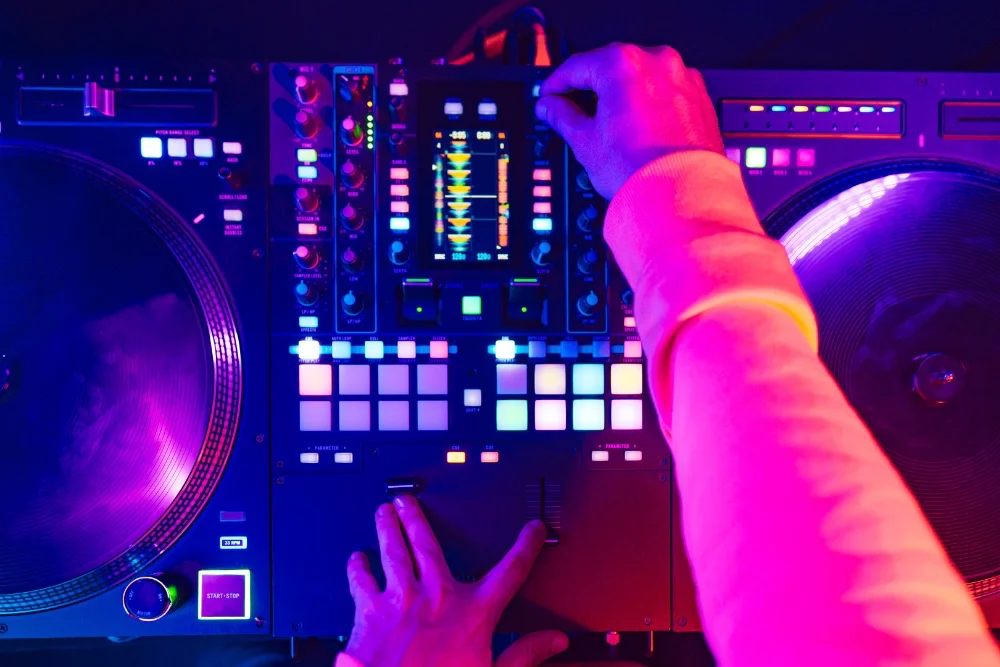You might think you’re already the life of the party, but wait till you’ve mastered integrating samples and loops into your DJ sets; that’s when the real magic happens.
By using samples, you can sprinkle a bit of sonic fairy dust over the crowd, adding unexpected twists and turns to well-known tracks.
Loops, on the other hand, are your secret weapon for keeping the energy high, allowing you to extend a beat until the dance floor is begging for mercy.
As you develop your skills, you’ll find that these tools not only enhance your performance but also define your unique sound.
So, let’s get started on the journey to becoming a loop wizard and sample savant, keeping your sets fresh and your audience hooked.
If you’re looking for the best free samples and loops on the web, check out SoundShockAudio’s collection of free samples and loops.
Key Takeaways
- Samples and loops add unexpected twists and turns to well-known tracks.
- Mastery of integrating samples and loops is essential for DJs.
- Incorporating samples adds texture and personal flair to DJ sets.
- Understanding the mechanics of loops is essential for effective use.
Introduction to Using Samples and Loops in DJ Sets

You’re entering a realm where precision meets creativity, where sampling and looping become the heartbeat of your DJ set.
Grasping the basics of these techniques is essential, as they’ve evolved to shape the modern soundscape, allowing you to layer textures and rhythms with finesse.
Master these tools, and you’ll transform tracks into a seamless flow that captivates your audience.
Understanding the Basics of Sampling and Looping in DJing

In the realm of DJing, mastering the art of sampling and looping is key to elevating your sets, as it allows you to blend tracks seamlessly and infuse your own creative flair. If you’re using FL Studio Mobile and want to enhance your skills, learn how to add loops and samples to FL Studio Mobile for even more creative possibilities.
A loop is a precise repetition of beats—typically in multiples of four—that you can manipulate to extend mixes, synchronize rhythms, or avoid tricky outros. You’ll want to use loops sparingly; overuse can lead to a monotonous sound, but the right touch at the perfect moment can work wonders.
Timing is everything when looping. It’s about catching the groove and locking it in to keep the dance floor engaged. Think of loops as your building blocks, layering them to construct a soundscape that’s both familiar and fresh. With practice, you’ll turn looping into an art, crafting transitions that are smooth and remixes that dazzle.
The Evolution of Sample and Loop Use in Modern DJ Sets
As you delve into the evolution of sample and loop use in modern DJ sets, you’ll find that these techniques have transformed from simple track extensions to complex elements that shape today’s electronic music landscapes. Modern DJs wield loops and samples not just as tools for smooth transitions, but as creative weapons to craft a unique sonic experience.
- Seamless transitions: Utilize loops to bridge between tracks without breaking the flow.
- Live remixing: Manipulate loops in real-time to add a personal touch to played tracks.
- Layering textures: Blend multiple loops to add depth and complexity to your mixes.
- Strategic placement: Choose the right moments for loop insertion to maintain energy without overwhelming the original track’s essence.
Mastering these techniques can set you apart in the dynamic world of electronic music DJing.
The Art of Sampling in DJing

As you refine your DJing craft, incorporating samples becomes crucial for adding texture and personal flair to your sets.
You’ll need to navigate a diverse array of sample types—from vocal snippets to instrumental loops—to keep your audience engaged.
Mastering the techniques to weave these elements seamlessly into your mix will set you apart as a DJ who not only plays music but redefines it live.
Exploring Different Types of Samples for DJ Sets
You’ll find three main types of samples to enhance your DJ sets: vocal snippets, instrumental loops, and unique sound effects. Each brings a distinct flavor to your mix, setting you apart as a DJ with a keen ear for detail and mood.
- Vocal Snippets: Extract captivating phrases or hooks to sprinkle over beats, creating instant recognition and energy.
- Instrumental Loops: Layer rhythmic patterns or melodies to build complexity or drive a transition.
- Unique Sound Effects: Introduce texture and atmosphere with sounds that intrigue the ear and heighten the sensory experience.
To find samples, dig through old records, explore genre-specific packs, or record original sounds to craft your signature style.
Techniques for Effectively Incorporating Samples into Your Mix
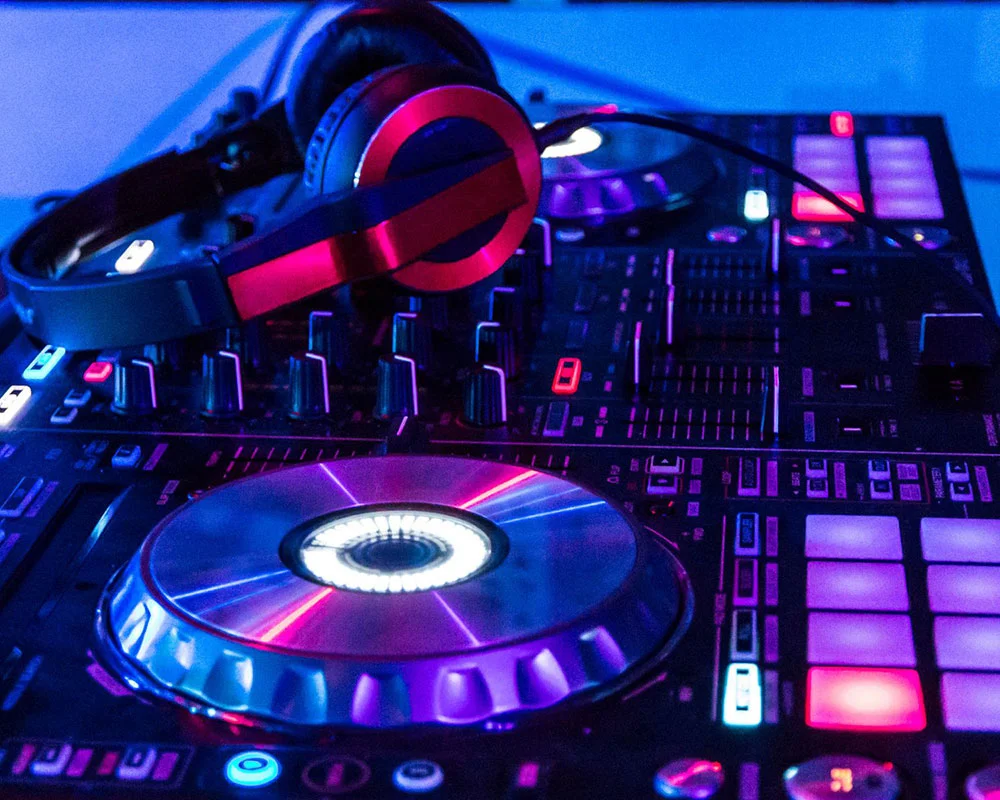
When incorporating samples into your mix, it’s crucial to select sounds that complement the current track and maintain the flow of your set. Aim for a natural blend; avoid cutting vocals or effects abruptly.
Master loop rolls by progressively halving the loop length to build intensity before a drop. Layering is your creative ally—try looping an acapella vocal over a driving kick drum for a personalized touch.
Focus on the track’s heartbeat; use loops to highlight hooks or instrumental gems. Remember, less is often more with loops. The art lies in timing—know when a loop uplifts the mix versus when it might clutter your sound.
It’s this discernment that sets apart the skilled DJ from the novice.
Mastering Loop Use in DJ Sets

As you gear up to master loops in your DJ sets, you’ll find that understanding the mechanics is just your starting point.
You’ve got the power to turn a simple beat into an electrifying build-up or a smooth transition, all with the strategic use of loops.
Let’s explore how to deploy this technique effectively, keeping your audience locked into the groove while showcasing your creative flair.
How Loops Work: A Beginner’s Guide

Understanding how loops work is crucial to mastering their use in your DJ sets, allowing you to create dynamic mixes with seamless transitions. Whether you’re building energy or maintaining a groove, loops are your go-to tool for a polished performance.
Here’s what you need to know:
- Beat Counts: Work with 4, 8, 16, or 32 beat loops for cohesion.
- Auto vs. Manual Loops: Use Auto for precision or Manual for on-the-fly control.
- Creative Effects: Experiment with Loop Rolls for a playful sound.
- Strategic Use: Loop sparingly to keep your set fresh and engaging.
Hone your skills by practicing with your software’s loop functions and studying mix examples. Mastering loops is about timing, technique, and taste.
Creative Ways to Use Loops in DJ Sets for Enhanced Performances
Now that you’ve got the basics of looping down, let’s explore several innovative ways you can use loops to elevate your DJ sets and captivate your audience.
Harness the power of loop rolls for electrifying builds—just make sure your timing is impeccable to nail the drop.
Live mashups are within reach by layering a well-known vocal loop over a contrasting track, creating a unique blend that’s unmistakably yours.
Get experimental by layering multiple loops, like a looped acapella over a punchy kick drum, to concoct a mix that’s fresh and unexpected.
Remember, understanding song structure and honing your layering finesse are key to seamless transitions.
Use loops judiciously—timing is everything for that killer impact.
Essential Tools for Sampling and Looping
Your choice of sampler can make or break your DJ set’s dynamism, so it’s crucial to select one that fits your style and technical needs. Weighing the pros and cons of software versus hardware samplers will determine your setup’s flexibility and the tactile control at your fingertips.
Let’s explore the features and functionalities that will keep your mixes fresh and engaging.
Choosing the Right Sampler for Your DJ Setup
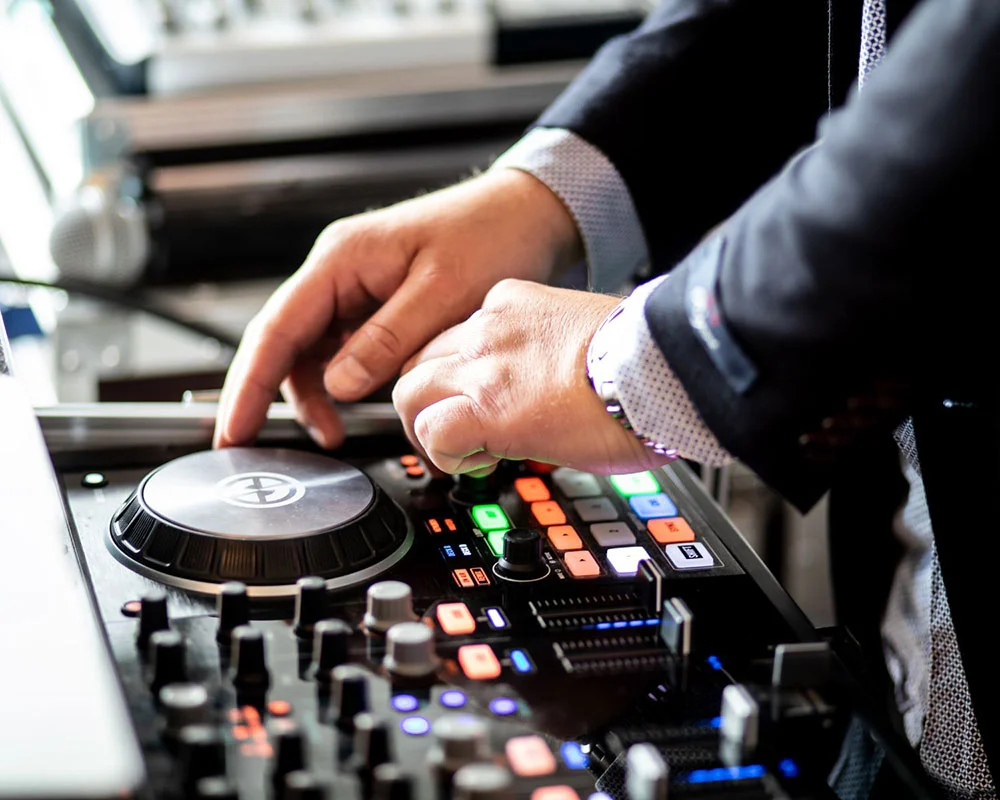
Selecting the appropriate sampler is crucial for enhancing your DJ performances with seamless loops and dynamic samples. As you dive into the realm of sampling, you’ll want to consider these key factors:
- Functionality: Does the sampler integrate well with your current setup and offer the creative control you need?
- Compatibility: Ensure the sampler works seamlessly with your software and hardware.
- Usability: Look for a user-friendly interface that doesn’t hinder your flow.
- Flexibility: Choose a sampler that can handle various genres and adapts to your evolving style.
Software vs. Hardware Samplers: Pros and Cons
When choosing between software and hardware samplers for your DJing, it’s essential to weigh their distinct advantages and drawbacks to find the best fit for your performance style.
Software samplers, integrating seamlessly with DJ platforms like Serato and Rekordbox, offer precision in loop creation with defined start and end points. You’ll appreciate the convenience of triggering loops directly from your controller or mixer, especially if you’re a digital DJ embracing the full potential of your software.
On the flip side, hardware samplers deliver a tactile experience, letting you physically interact with your loops. They provide an immediacy that can be crucial in a live setting, where feeling the beat and making split-second decisions are part of your art.
The choice hinges on whether you prioritize convenience or hands-on control.
Looking for all types of DJ gear and tools, check out DJ Tech Tools.
Finding and Downloading Quality Samples and Loops

You’ll want to scout for top-notch samples and loops to elevate your DJ sets, ensuring each track resonates with your creative vision.
Begin by exploring esteemed online resources, where a treasure trove of crisp, club-ready sounds awaits your discovery. If you’re looking to diversify your collection, explore the best free samples and loops for every genre available.
Be discerning when selecting sample packs, focusing on those that mesh seamlessly with your style and the energy you aim to channel through your mixes.
Best Online Resources for DJ Samples and Loops
To elevate your DJ sets with high-quality audio elements, it’s essential to explore several online resources that offer an extensive range of samples and loops for download. Here’s a list of top-notch platforms where you can find the crisp beats and unique sounds that’ll make your mixes stand out:
- Splice: A favorite among producers for its vast, genre-spanning library and user-friendly interface.
- Loopmasters: Offers a comprehensive collection of high-quality loops and samples catered to DJs and electronic music creators.
- Beatport Sounds: Provides a robust selection of DJ tools, from loops to full tracks, specifically for the dance music community.
- Prime Loops: Delivers a diverse array of sample packs and loops that are tailored for modern music production.
Dive into these resources and curate your signature sound with the best samples the internet has to offer.
Tips for Selecting the Perfect Sample and Loop Packs
Having explored top online resources for samples and loops, you’re now ready to zero in on the perfect packs that’ll elevate your DJ sets.
Be selective; not all sounds are created equal. Your packs should mirror your musical signature, blending seamlessly with your genre’s pulse.
Opt for high-fidelity, professionally crafted samples—these are your sonic building blocks, and quality is non-negotiable.
Check compatibility; your gear and software should integrate these sounds as if they were native.
Dig for unique audio gems that promise to set your mixes apart, avoiding the overplayed to maintain originality.
Integrating Percussion Loops for Dynamic DJ Sets
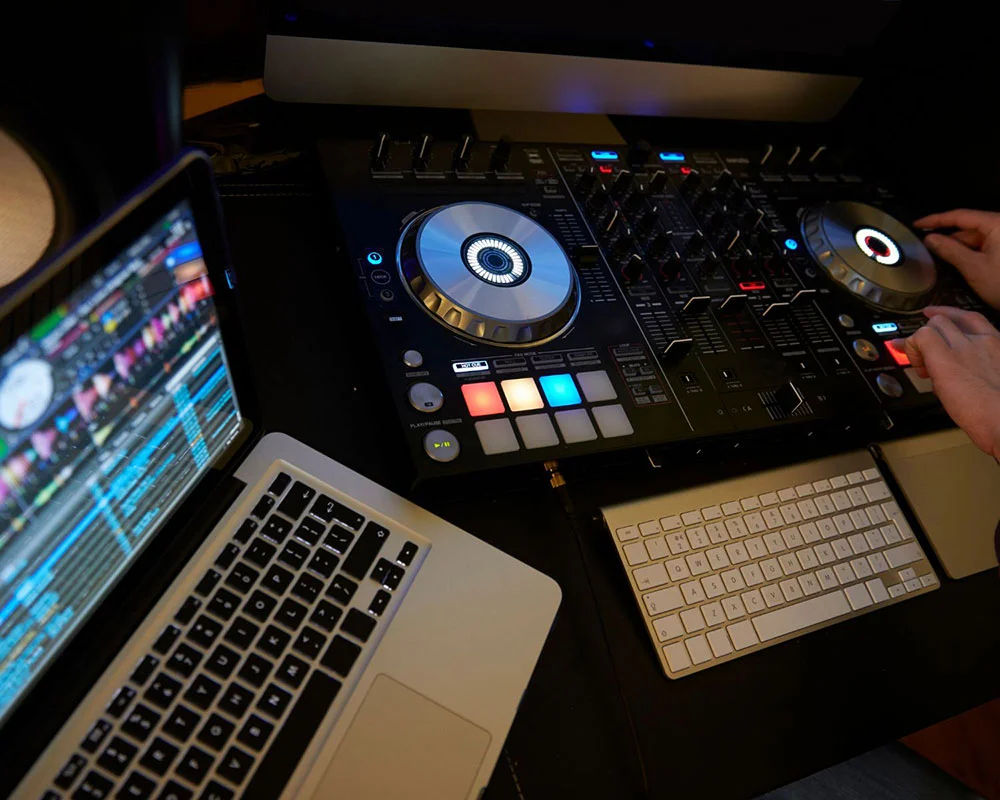
As you master the art of DJing, integrating percussion loops can transform your sets into dynamic sonic adventures. You’ll need to craft unique rhythms that complement the tracks you’re spinning, ensuring they enhance rather than overpower the mix.
Balancing these loops is key; it’s about finding that sweet spot where your percussion samples contribute to a cohesive and compelling musical journey.
Crafting Unique Rhythms with Percussion Loops
Incorporating percussion loops into your DJ sets, you’ll unlock the potential to craft unique rhythms that elevate the energy and dynamism of your performance. These loops can act as the backbone of your mix, providing a constant groove that you can manipulate to your creative whims. With technical skill and an ear for innovation, you can transform a simple beat into a signature sound.
To truly stand out, consider the following:
- Layer multiple loops to build complex polyrhythms.
- Tweak EQ settings to blend loops seamlessly with tracks.
- Use effects judiciously to add texture and movement.
- Sync loops meticulously to maintain a cohesive mix.
Balancing Percussion Samples for Cohesive Mixes
To seamlessly integrate percussion loops into your DJ set, you’ll need to balance them carefully to ensure they complement, rather than overpower, the existing tracks. Select loops that enhance the groove without clashing with the track’s core rhythm. You’ll want to avoid abrupt cuts, especially around vocals or delicate pad effects. When layering loops, consider their sonic frequency—mixing a high-hat with a mid-frequency conga can add a dynamic feel without muddying the sound.
Timing is critical; introduce loops when they’ll make the most impact, like during a build-up or breakdown. Use them sparingly—think of percussion loops as spices that add flavor without overwhelming the dish. Your goal is to craft a dynamic, yet cohesive soundscape that keeps your audience engaged and energized.
Advanced Techniques for Sample and Loop Integration
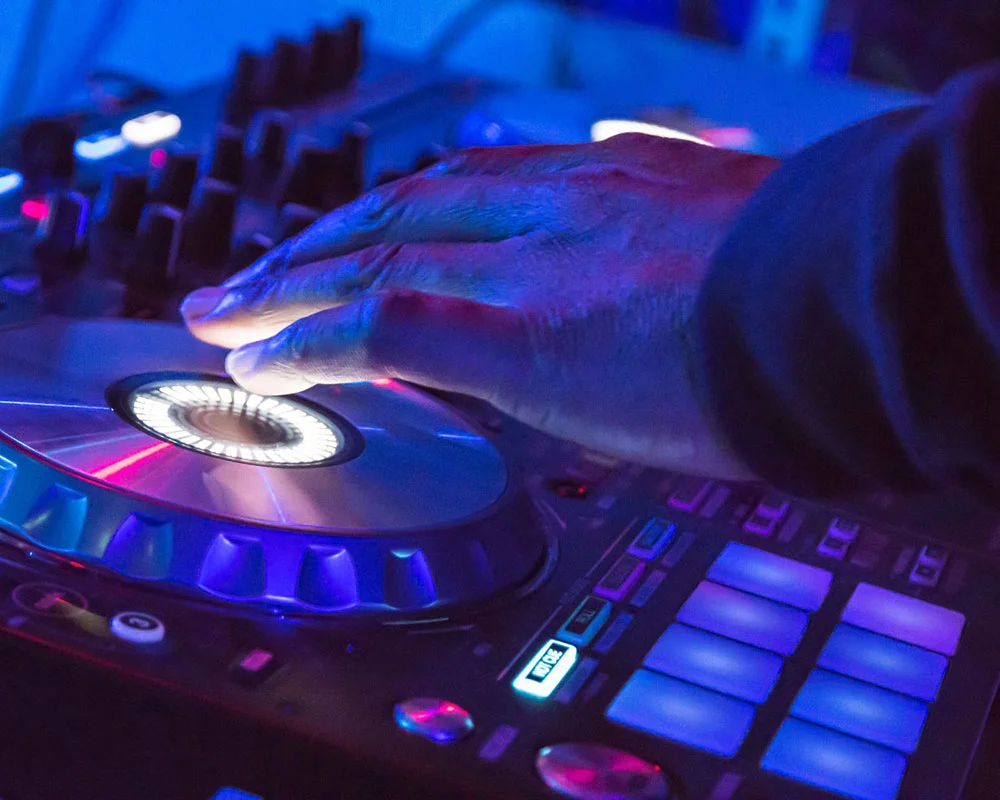
As you master the basics of looping, you’re ready to explore the art of layering and sequencing loops to elevate your DJ sets.
Inject your performances with a dose of innovation by manipulating samples on-the-fly, capturing the crowd’s energy in real time.
Master these advanced techniques, and you’ll craft soundscapes that resonate with your audience, blending familiar beats with unexpected rhythms.
Creative Tips for Layering and Sequencing Loops
You’ll need to think outside the box and within the rhythm when layering and sequencing loops for a standout DJ set. Mastering this art involves more than just looping beats; it requires a keen ear and creative finesse.
Here are some advanced tips:
- Experiment with Cross-Genre Layering: Mix a classical string quartet loop with a deep house beat for an unexpected twist.
- Use Loop Rolls Strategically: Drop them right before a big transition to amplify the crowd’s anticipation.
- Craft Live Mashups: Overlay an iconic vocal loop over a contrasting instrumental to create a signature blend.
- Play with Loop Lengths: Alternate between different loop sizes to keep the energy dynamic and engaging.
Expert Tricks for Manipulating Samples in Live Performances

Every DJ set can be transformed with the right manipulation of samples and loops. This offers limitless possibilities to elevate your live performance.
Dive into layering multiple loops, like a looped acapella vocal over a kick drum. This allows you to concoct unique mixes that captivate the crowd.
Master loop rolls for that climactic build before a drop. Hone your timing to whip up frenzy and create an electrifying atmosphere.
Live mashups become your playground as you layer familiar vocals over unexpected tracks. This showcases your creativity and ability to think outside the box.
But remember, use loops sparingly. Your goal is to enhance, not overwhelm.
Become intimate with your software and hardware’s capabilities. This knowledge is your toolkit for live performance innovation.
The art lies in knowing when and how to weave these elements seamlessly into your set.
Common Challenges and Solutions When Using Samples and Loops
You’ll often find that syncing samples and loops perfectly with your live mix is a tricky endeavor. To tackle this, you need to refine your timing, ensuring that your cues are precise and that loops blend seamlessly with the underlying tracks.
Organize your library meticulously, with well-labeled and easily accessible samples, to avoid fumbling mid-set and maintain the flow of your performance.
Overcoming Timing and Sync Issues in Live Sets
In your live DJ sets, dealing with timing and sync issues when using samples and loops can be challenging, but there are effective solutions to ensure your mix stays on beat. Mastering these techniques can elevate your performances and provide a seamless experience for your audience. Here’s how to tackle common timing and sync challenges:
- Use the quantize feature in your DJ software to automatically align your loops with the beat grid.
- Practice manually beatmatching loops with the playing track to develop your ear and tighten your mixes.
- Set cue points strategically to trigger loops in time with the music.
- Familiarize yourself with your tracks’ structures to anticipate changes and sync loops accordingly.
Best Practices for Organizing and Cueing Samples and Loops
After mastering timing and syncing, it’s essential to organize and cue your samples and loops efficiently to streamline your DJ sets. Tackling the challenge of setting accurate loop points requires practice and a deep understanding of your tracks’ structures.
Start by categorizing your loops and samples by genre, key, and tempo, allowing for quick retrieval during performances. Use color-coding or tagging systems in your DJ software for visual cues.
When cueing, ensure that loops blend seamlessly, avoiding abrupt cuts, especially with vocals or intricate pad effects. Remember, less is often more. Use loops judiciously to maintain the audience’s engagement, complementing the music rather than overwhelming it.
Familiarize yourself with your equipment’s looping capabilities and practice regularly to find the balance that elevates your sets.
Case Studies: Successful DJs Who Mastered Sampling and Looping

You’ve seen the pros effortlessly blend beats and warp sounds, turning samples and loops into signature elements of their sets.
By examining iconic DJ performances, you’ll glean technical insights and creative strategies that have propelled these artists to the top of their game.
Let’s explore the lessons learned from industry giants who’ve turned the art of sampling and looping into a science of crowd control.
Analyzing Iconic DJ Sets for Inspiration
To truly grasp the art of using samples and loops in your DJ sets, let’s dive into the techniques of iconic DJs who’ve turned looping and sampling into an elevated form of musical expression. By analyzing their sets, you’ll notice patterns and strategies that you can incorporate into your own performances.
Here are key elements to look for:
- Innovative Loop Layering: Observe how DJs layer different loops to add texture and complexity to their sound.
- Creative Sample Triggering: Pay attention to the timing and application of sample triggering for dynamic effects.
- Seamless Loop Integration: Notice how loops are woven into tracks to create smooth transitions.
- Audience Interaction: See how samples and loops are used to engage and respond to the crowd’s energy.
Embrace these techniques to enhance your sets with a touch of the masters’ finesse.
Lessons Learned from Professional DJs
Every great DJ you admire has, at some point, harnessed the power of sampling and looping to elevate their performances. You’ve seen them seamlessly transition tracks, prolong grooves, and craft live remixes before an entranced crowd. They’ve learned that less is often more, using loops sparingly but with precision to create moments that define their sets.
Here’s a table showcasing elements that successful DJs consider when using loops and samples:
| Aspect | Consideration | Example |
|---|---|---|
| Loop Length | Align with the track’s rhythm section | 4 or 8 bars |
| Timing | Sync with the song’s peak moments | Drop transitions |
| Selection | Choose distinctive and rhythmic parts | Vocal cuts |
| Layering | Combine loops to add depth | Percussion over bassline |
| Practice | Master timing and triggering | Rehearsing with different genres |
Embrace these insights, and you’ll not only refine your technique but also unlock new realms of creativity in your DJ sets.
Elevating Your DJ Skills with Samples and Loops

Mastering the strategic integration of samples and loops in your DJ set can transform an average performance into an unforgettable sonic journey. By using these elements sparingly and with precision, you elevate the experience for your audience, ensuring each twist and turn in the set feels fresh and exciting. Remember, it’s not about overloading your mix but about adding depth and texture at just the right moments.
- Refine your timing: Perfect the art of when to introduce loops and samples for maximum effect.
- Develop a signature sound: Use unique samples to create a recognizable style.
- Practice transitions: Seamlessly blend loops into tracks to maintain energy and flow.
- Be selective: Choose samples and loops that complement the tracks you’re playing and enhance the overall vibe.
Frequently Asked Questions
How can samples and loops be used to create sound effects as a DJ?
A DJ can use samples and loops to create sound effects by manipulating pre-recorded sounds. This could include altering the pitch, adding reverb or delay, or layering multiple sounds together. The effects can be stored in a digital library and triggered during a performance.
What role do these samples play in crowd control during a DJ set?
Samples play an important role in crowd control during a DJ set. They help to maintain energy levels on the dance floor by providing familiar hooks or exciting drops. Good use of samples can keep the audience engaged and prevent them from losing interest.
How is timing important when using samples and loops in a DJ set?
Timing is crucial when using samples and loops in a DJ set. Each sample must be launched at the correct moment to ensure it fits rhythmically with the other music being played. This requires careful listening skills and good hand-eye coordination.
Can DJs use their hands directly to manipulate samples and loops?
Yes, DJs often use hardware controllers that allow them to manipulate samples and loops directly with their hands. These controllers may have buttons, knobs, or touch-sensitive pads that trigger different sounds or effects when pressed or moved.
How can practicing with my hands improve my skills in using samples and loops as a DJ?
Practicing with your hands can greatly improve your skills in using samples and loops as you become more familiar with your equipments layout. It also enhances your timing ability – an essential skill for launching each sample accurately within the mix’s rhythm structure.
How Do You Use Loops in Djing?
You’ll use loops to maintain rhythm, enhance transitions, or add layers. Loop beats or phrases, then mix creatively—whether extending a buildup or crafting a live mashup. Practice makes perfect, so keep experimenting.
What Is the Loop Function on a DJ Mixer?
You’ll find the loop function on a DJ mixer lets you repeat a chosen track segment to enhance your mix with seamless transitions or creative flourishes. It’s a crafty tool for dynamic performances.
What Is DJ Sampling?
DJ sampling is when you grab sound bites and mix them into your tracks to add a unique flavor or to punctuate moments, elevating your performances with a personal touch.
How Do You Organize a Set When Dj?
You’ll want to curate tracks that flow seamlessly, considering energy levels, keys, and tempo. Plan peaks and lulls, and always be ready to adapt live to the crowd’s vibe.



